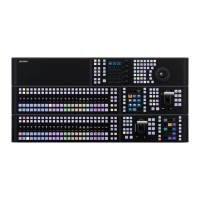Chapter
5
94
Transitions
Overview
Switching from the current output image to a new image
is referred to as a transition.
Switching a background image or key insertion/removal
can
be performed, depending on the transition.
The method for switching images (transition type) can be
set
, and the transition executed using the buttons and
fader lever on the control panel.
Independent key transition
In addition to common transitions, it is possible to
con
figure independent transitions for each key.
Executing an independent key transition in combination
wi
th a common transition enables different transition
types to be used for the background and keys.
Transition operation flow
Changing the background
To switch the background in a transition, select a
background for a next transition.
Select a background image using background A bus and
bac
kground B bus.
When set to flip-flop mode, background A is the existing
i
mage and background B is the new image. The
background always switches from background A to
background B. When the transition completes, the cross-
points of the background A bus and background B bus
interchange.
In bus fixed mode, depending on the transition, the cross-
poi
nts of the background A bus and background B bus do
not interchange.
For details, see “Flip-flop mode and bus fixed mode”
(page 104).
Inserting and removing a key
To insert/remove a key in a transition, select a key for a
next transition.
When a key that is not inserted in the current background
i
mage is selected, depending on the transition, the key is
inserted.
When a key that is inserted is selected, depending on the
tr
ansition, the key is removed.
You can also simultaneously insert and remove keys
when swi
tching the background.
You can also change the key overlay sequence (key
pr
iority), depending on the transition.
Select the current background
r
Select a next transition (see page 96)
Background Key
r r
Select a new background Set keys
r r
Select and set a transition type (see page 99)
r
Preview transition (see page 108)
r
Execute transition (see page 102)

